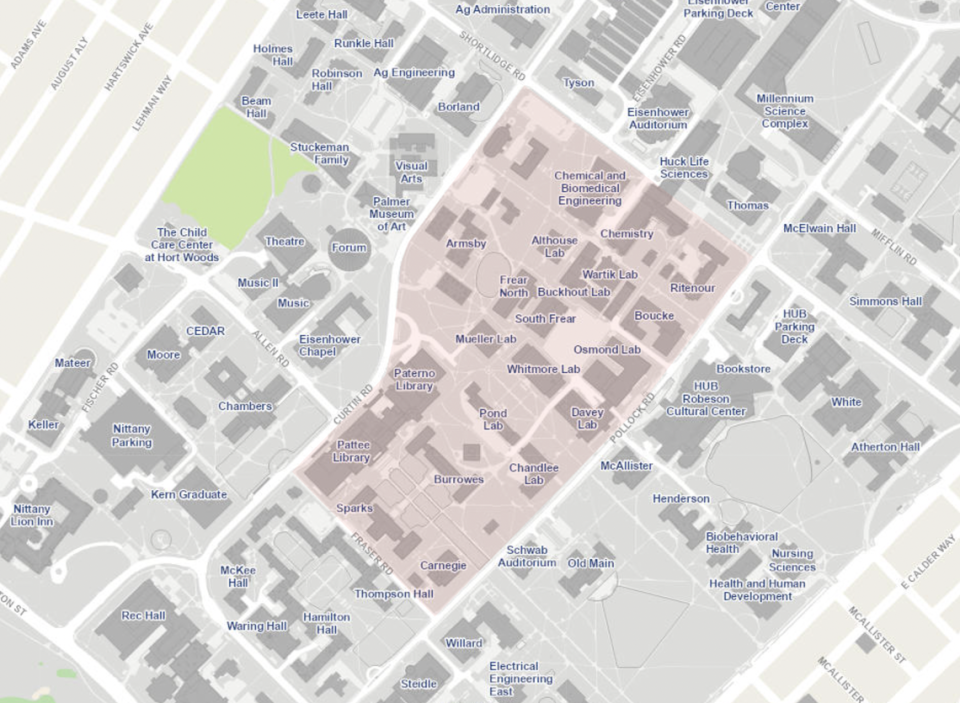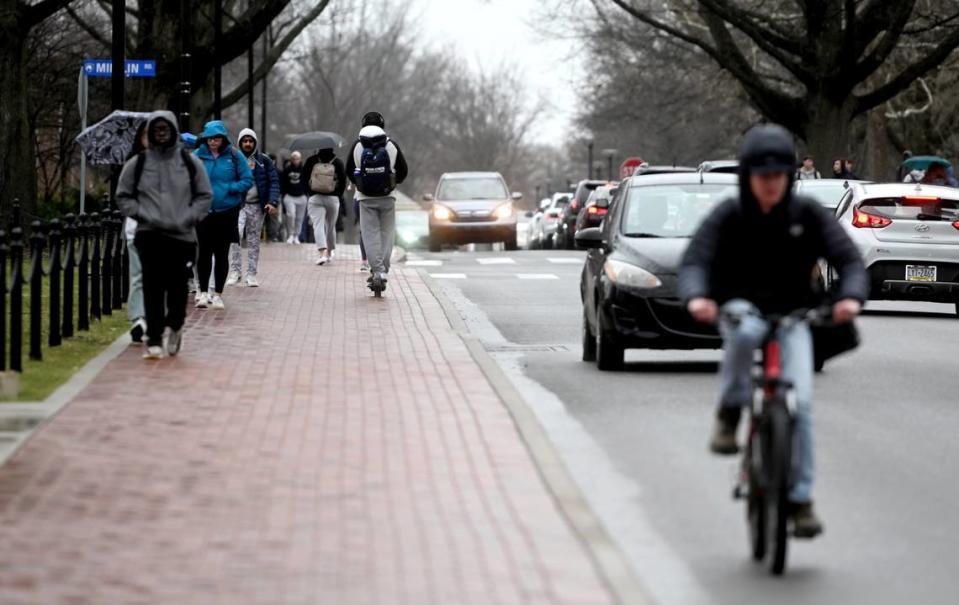Scooters are everywhere at Penn State, but are they allowed on campus? A commuter’s guide
If you’ve ever walked across Penn State’s University Park campus, you’ve likely been cut off by a speeding cyclist or a zigzagging rollerblader.
Penn State’s campus is always bustling with people on the go, and even everyday visitors might not know the ins and outs surrounding the many modes of transportation you’re likely to see. Some common devices are banned entirely by the university, while others could prompt tickets that carry a fine.
Here’s what you need to know about getting around on Penn State’s campus.
Biking at Penn State
Bikes present one of the most popular transportation methods for Penn Staters. As such, there are plenty of rules to follow if you’re interested in cycling around campus.
According to university policy SY16, which governs on-campus transportation and safety guidelines, bikes must be operated according to the Pennsylvania Vehicle Code. The code, outlined in excess online, is enforced in addition to the university’s own policy, which establishes guidelines for bicycle composition, registration and use.
Those who hope to use a bicycle on the University Park campus are technically required to register it online to receive a permit, which is then mailed to your local address. Registration is available online at transportation.psu.edu/bicycle-registration and bikeindex.org/psu.
Bicycles that have already been registered with the State College borough are valid on campus, according to the university’s official policy. Bicycles must be registered again once their two-year permits expire.
To receive approval and be acceptable for a permit, Penn State says a bicycle must be equipped with each of the following:
A red reflector on the rear, visible at a distance of 500 feet
A white front-facing light visible at a distance of 500 feet (if it is to be operated at night)
An amber reflector on each side, including on pedals and wheels
Permits should be attached to the middle of a registered bicycle’s seat tube or visible on the seat post. Regardless, it should face the front of the bicycle, Penn State’s policy says.
Additionally, Penn State says bicycles must meet the following requirements to be considered legal and treated as bicycles in Pennsylvania:
Weigh less than 100 pounds
Have at least two or three wheels at least 11 inches in diameter
Have operable pedals
Be powered by an electric motor rated no greater than 750 watts
Be capable of speeds no greater than 20 mph on a level surface when powered by only the motor source or throttle
“Motorized pedal cycles” are legal and treated as bicycles if they have operable pedals and a motor rated at 1.5 horsepower or less with a cylinder displacement of fewer than 50 cubic centimeters, university policy reads.
Once you’re ready to ride, Penn State requires you use on only approved bicycle routes and campus roads. Feel free to ride through on-campus malls and most pedestrian paths, but be sure to yield to pedestrians.
Bike use is prohibited on pedestrian pathways within the “limited bicycle zone” bounded by Fraser Road, Curtin Road, Shortlidge Road and Pollock Road. The zone is highlighted in light pink on the university-generated map below and available online at transportation.psu.edu/route-maps-resources.

Bikes on campus must be parked on racks, Penn State’s policy states. Exceptions are made for indoor bike parking areas, including those inside some residence halls.
Abandoned or non-registered bicycles that are parked on campus, “hindering university operations” or obstructing steps or handicap ramps could be removed or impounded by Penn State’s Transportation Services, the university says. The university will not reimburse riders for costs associated with locking devices that could need to be removed in such a scenario.
If impounded bikes remain unclaimed for more than 90 days, Penn State says they “shall be deemed a gift to the university, to be disposed of through appropriate university channels.”
Can I skate on campus?
Well, it depends on your device. The use of skateboards and skateboard-like devices, like longboards and Onewheels, is prohibited on campus, according to university policy.
Meanwhile, roller skates, in-line skates, man-powered scooters, sleds, hoverboards and similar devices are allowed, but their use is restricted to pedestrian sidewalks in certain scenarios. Those on campus can use them on sidewalks “provided they yield the right-of-way to pedestrians on foot and follow traffic rules at intersections,” the university’s policy reads.
Acrobatics, or actions that result in both wheels coming off of the ground at the same time, are banned entirely.

What about scooters?
Although they’re seemingly popular with students these days, electric scooters are not allowed on campus.
Electric scooters are considered motor-driven devices, a category that covers devices that are “propelled by internal combustion, battery or other mechanical or electro-mechanical means.” No matter how they move, these devices are banned from campus paths and roadways in most circumstances.
“Motor-driven devices that do not meet the PA Vehicle Code requirements for operation on a public highway are prohibited from use on university property,” Penn State’s official policy reads. Their use is restricted within buildings and on roads, sidewalks, bike paths and shared pathways, the university says.
Penn State enforces a ban on motor-driven devices like scooters for two reasons, according to University Police and Public Safety officials.
“First, the Pennsylvania Vehicle Code does not allow scooters (with or without motors) on the roadways because, in Pennsylvania, scooters are not categorized as a vehicle,” said Jacqueline Sheader, UPPS’s public information officer. “Secondly, due to the design of the e-throttle powered electric motors of e-scooters, when combined with a user’s weight, there is not an inherently reliable way for the user to slow or stop their trajectory without endangering themselves and those around them.”
Man-powered scooters are allowed on campus, but their use is restricted to sidewalks and pedestrian pathways.
Segways and electric mobility devices
According to Penn State’s official policy, the use of electric personal assistive mobility devices (EPAMDs) is allowed on campus in select scenarios. These devices are defined as “a self-balancing one- or two-wheeled device with an electric propulsion system designed to transport only one person for personal mobility purposes,” the university says. Legal EPAMDs can’t be capable of exceeding 19 mph.
EPAMD use is restricted to only sidewalks. Users are asked to use crosswalks to crossroads and yield to pedestrians when necessary.
Riding of EPAMDs inside buildings is prohibited, but those with disabilities who have “a documented need to use the device inside of buildings” can proceed after receiving clearance, Penn State says. The university’s policy says it will consider requests from students or employees who wish to use EPAMDs indoors “as a reasonable accommodation” under the Americans with Disabilities Act.
Requests for indoor EPAMD use must be approved by Penn State’s Student Disabilities Resources office, located at 116 Boucke Building and available by phone at 814-863-1807. Faculty and staff should contact their human resources representative or Penn State’s Affirmative Action Office, located at 328 Boucke Building and available by phone at 814-863-0471.
Users must register EPAMDs with the university. Registration requires the review of university safety procedures, plus hands-on training for those who may need an EPAMD for “university business” or as part of their job responsibilities.
Similar to bikes on campus, EPAMDs should be equipped with a front-facing lamp and a red reflector on the rear when the devices are used between sunset and sunrise.
Penalties for policy violations
Overlooking Penn State’s transportation regulations could prompt a handful of complications for students, employees and campus visitors alike.
Some violations are punishable by a small fine if offenders are ticketed by university police, Penn State’s policy states. Ticket revenue helps to fund the Bicycle Education and Enforcement Program (BEEP), which works to educate the community on safety matters and support on-campus transportation.
Potential penalties include:
Parked or affixed to handrails, handicap ramps, wheelchair curb cuts, etc. — $75 fine
Moving violations, including excessive speed, stop sign violations, wrong way on a one-way street, passing on the right of traffic, etc. —$50 fine
Equipment violations, including a lack of reflectors, failure to use front-facing white light between dusk and dawn, etc. —$25 fine
Skateboarding on university property —$25 fine
Use of unauthorized devices on a roadway —$25 fine
Failure to yield to pedestrians on a walkway —$25 fine
Failure to properly register a bicycle — $10 fine
“Someone who uses an unauthorized device on campus can and will be subjected to a ticket with a fine,” Sheader said.
First-time offenders can have their first ticket waived by completing and passing an online training course through BEEP within 10 days of the ticket’s issue date. All additional tickets are subject to collection.
If the university does not receive a required payment within 30 calendar days from a violation that prompted a fine, Penn State increases the fine by $3 each subsequent day.
Those who receive tickets in error or wish to appeal them can contact Penn State’s alternative transportation program coordinator by emailing biking@psu.edu. Appeals must be received within 20 days from the date of the violation.
Students or employees who violate campus transportation regulations could also face disciplinary action from the university, Penn State’s official policy says. Others who visit campus could instead face citations for criminal trespass if violations continue or are repeated.
Permitted transportation devices should be parked on campus at places “clearly designated by the presence of bicycle racks,” Penn State’s policy says. Devices cannot be parked in automobile parking spaces, lawn areas, shrubs or flower beds, driveways, inside buildings, sidewalks, trees, railings, light poles, entrances to buildings or in places that “hinder pedestrian travel.”
Additionally, if transportation devices are left on campus racks for more than 48 consecutive hours, they could be found in violation of university policy. Bike storage rooms or residence areas are an exception, the university says.
Failure to comply with transportation device parking regulations could result in the temporary confiscation of the device and a $75-per-device fine.
Other transportation options
If walking or using a personal device isn’t your style, there are other options to get around at the University Park campus.
Perhaps the most convenient method comes through the Centre Area Transportation Authority (CATA), which operates buses and shuttles throughout six municipalities. CATA runs several no-fare bus loops on campus, including the White Loop, the Blue Loop and the Red Link, that also stop in downtown State College and venture out toward Mount Nittany Medical Center. You can see hour-by-hour schedules and live service maps online at catabus.com/route-page/campus-service-schedule.
Additionally, Penn State Transportation Services offers its own two-route Campus Shuttle program that provides no-fare transportation across the University Park campus. The two shuttle routes, which are wheelchair-accessible, serve at least 20 stops across campus and downtown State College on weekdays. Schedules, including access to real-time service maps, are available online at transportation.psu.edu/campus-shuttle.

